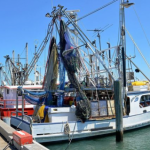Agencies Mull Options to Prepare for Future Domoic Acid Events
 In 2015/2016, there was an unprecedented bloom of a single-celled plant called Pseudo-nitzschia in ocean waters, which resulted in elevated levels of domoic acid in Dungeness crab and rock crab. The elevated levels of domoic acid in crab along the West Coast impacted California fisheries from Santa Barbara to the Oregon Border. The conditions that support the growth of Pseudo-nitzschia are impossible to predict, but tend to be more common in the warmer months of the year. Crustaceans, fish and shellfish are capable of accumulating elevated levels of domoic acid in their viscera and muscle tissue. Domoic acid was discovered in California in 1991. Shortly after, in 1993, the California Department of Public Health (CDPH) initiated its marine biotoxin monitoring program and now, through a network of volunteers, routinely collects phytoplankton and bivalve shellfish samples from a number of sampling sites along the coast year-round. Read the rest here 15:41
In 2015/2016, there was an unprecedented bloom of a single-celled plant called Pseudo-nitzschia in ocean waters, which resulted in elevated levels of domoic acid in Dungeness crab and rock crab. The elevated levels of domoic acid in crab along the West Coast impacted California fisheries from Santa Barbara to the Oregon Border. The conditions that support the growth of Pseudo-nitzschia are impossible to predict, but tend to be more common in the warmer months of the year. Crustaceans, fish and shellfish are capable of accumulating elevated levels of domoic acid in their viscera and muscle tissue. Domoic acid was discovered in California in 1991. Shortly after, in 1993, the California Department of Public Health (CDPH) initiated its marine biotoxin monitoring program and now, through a network of volunteers, routinely collects phytoplankton and bivalve shellfish samples from a number of sampling sites along the coast year-round. Read the rest here 15:41
Share this post
Related
This site uses Akismet to reduce spam. Learn how your comment data is processed.















































Leave a Reply